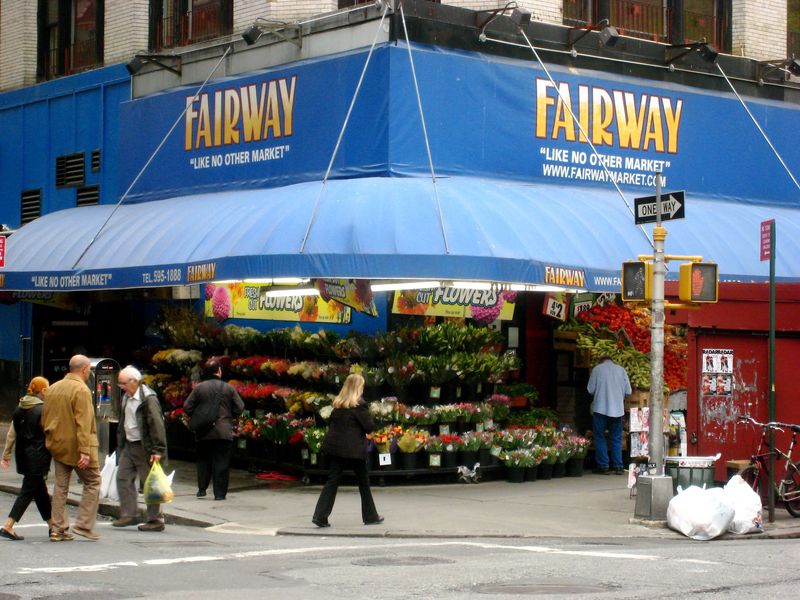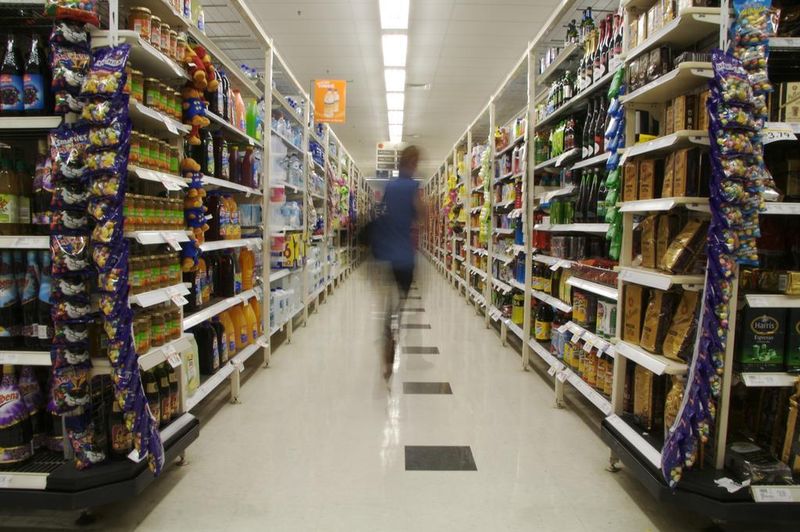It's a Big Box Grocery Store World—And There Could Be a Better Way
My first visit to a Fairway was in the fall of 2006, sometime during my orientation week at Columbia. Set in a giant warehouse under the 12th Avenue viaduct, the Harlem Fairway felt urban and industrial and entirely unlike the big chain grocers—Giant, Safeway, later Wegman’s—of my ur-suburban childhood outside of Baltimore.

The grocery stores I knew had wide, sensibly ordered aisles, shopping carts the size of European hatchbacks, and oppressively white lights that wrapped everything in a slick polyvinyl sheen. But not Fairway. Aisles there were high and narrow and deliberately disorienting. Potatoes and lemons tumbled down long raked chutes like skeeball alleys. The colors were brown and green, as though the whole place had been assembled from cardboard boxes. There was the cold room: a rack of orange parkas beside a swinging black door and, inside, shelves of meat and banks of ice loaded with fresh fish. There were guys in there who seemed to know which fish was which and how I was supposed to cook them. It all felt pretty ramshackle, almost seedy, with none of the high-gloss finish you’d find elsewhere, but it was also personable and personal. It really was, as the signs and awnings proclaimed, “Like No Other Market.”
When Fairway declared bankruptcy a few weeks ago, I happened to be house-sitting for friends in Red Hook, a few blocks from another Fairway, almost (though not quite) as good as the Harlem branch—same colors, same scale, same confounding layout. “Fairway, Unable to Fend Off Rivals, Files for Bankruptcy,” the Times blared on May 3, and four days later, “No Longer a Market Like No Other, Fairway Fades.” The supermarket had embarked on an ill-fated expansion scheme, opening locations in the suburbs and even planning to anchor food retail at Hudson Yards, a deal that fell through a year ago to the tune of $3.5 million.
Unable to compete with the likes of Whole Foods (and stupidly opening locations where Whole Foods already had footholds), Fairway had gone deep into debt. In scaling up, the market like no other had failed to replicate what Timesjournalist Ginia Bellafante described as its “endearingly chaotic, unpolished New York retail style.” They couldn’t replicate the slapdash look, the freewheeling layout, the urbane indifference to polish in the suburbs. Fairway grew up, moved out of town, and forgot its roots. It became any old grocery store.
I was in Red Hook that week because I’d just returned to New York after four-and-a-half years living in Mumbai, a city whose chaos and lack of polish endear it to some and repel many others. In India, I never went to grocery stores (the only one near my house, called Nature’s Basket, was a specialty shop stocked with imported goods and pricey cheeses and organic eggs, its cool white light and tidiness reminiscent of the Giants and Safeways of my childhood). I bought my vegetables from the vendor at the end of my lane, eggs from the ladies across the road, bread from A-1 bakery down the street, fish from a roadside fishmonger in the old village behind St. Andrew’s Church a five-minute walk away, and everything else at one of my neighborhood’s two big open-air markets, both of them strung along the margins of narrow (but still traffic-clogged) roads ten minutes from my front door.
Living in a market culture has transformed my longstanding distaste for grocery stores—their cold light, their offensively inoffensive music, those perfect dystopian pyramids of perfect dystopian oranges—into something like horror. American grocery stores work very hard to eliminate even the slightest hint of perishability from our shopping experience, doing for our foodstuffs what American morticians do for our corpses: embalming them so they’re neither alive nor dead but in uncanny suspension. After my time in Mumbai, groceries seem essentially inhuman: sterile, anodyne, odorless. People are dirty animals; we leave debris, and Mother Nature is no perfectionist. Grocery stores creep me out.

To walk into a grocery store is to look at America in a very harsh vanity mirror. All those fluorescents can’t help but reveal our worst spiritual blemishes: our paranoid germophobia, our fixation on efficiency and taxonomical order, our uncontrollable acquisitiveness. The plasticine fruits and glistening, flawless vegetables help us to escape, or at least ignore, the inevitability of death and decay. At the high-end, the commodification of virtue in the form of chia seeds and organic gluten-free whatever pats us on the back for mindfulness while insidiously suggesting that we can be immortal—if only we’ll spend.
Like fast food in the Cold War era, grocery stores offer a reassuring illusion of constancy in an inconstant world. Those apples may be local and seasonal and organic, but the stores, and often the products themselves, will look the same wherever you go. Big box stores extend that experience to the level of existential nightmare, the American experience reduced to its essential moreness, bleached and shrink-wrapped for easy transport.
Markets are the opposite: messy, redundant agglomerations of stalls, each its own tiny business, many of which sell identical, imperfect products. Shoppers have to pay each vendor separately (and in cash), which slows things down. Pricing, set by wholesale vendors and fluctuating demand, can be opaque. Buying in bulk is tough. Mice and bugs and the rotting detritus of cast off cauliflower leaves are commonplace. Markets force you to interact with people, force you to buy produce that, god forbid!, you’ve seen other people touch, force you to see the reality of rot as it happens on the ground around you, to confront the fact that food is life anddeath every time you buy it, cook it, eat it, and shit it out. Markets are downright un-American—and they’re wonderful.
After years of markets, I find Fairway a little less magical than I once did, but it still does a better job than any grocery store I know of capturing some of the spirit of a real marketplace. The labyrinthine layout forces you unwittingly to double back and walk past stuff you’ve already seen (a clever commercial feint). The coffee section smells like coffee and there’s someone there to chat with you while she weighs and grinds the beans. The light is warmer, the aesthetic more utilitarian, less studied. There’s nothing rotting on the ground, but it’s not unthinkable that there might be, either. It’s not quite a market, but at least you know where you are.
Cities across the country are fortunate to have grocery stores like these, and many of them are doing just fine. Bob Goldin, the CEO of food-industry research and consulting firm Technomic, told me Fairway’s demise has less to do with consumers wanting big, bright chains than with the store’s inability to maintain its specificity at scale. Small chains like Bristol Farms in Southern California, Stew Leonard in Connecticut and New York, and Sunset Foods in Chicago, he said, aren’t particularly well-designed and they stock fewer products than their larger competitors, but they know what their customers like. They keep managers on the floor, and they can bring in new products on request. They may or may not specialize in local produce, but they’re local themselves.
Our newish collective obsession with the pedigree and origins of the ingredients we buy is, on the whole, a good thing. It’s good to recognize that the meat we eat had to be raised and slaughtered to reach our tables, and that our vegetables grow in the ground and that people have to pick them and clean them. It’s good to be reminded that food doesn’t just emerge from the earth ready for consumption. It’s cultivated, altered, engineered. It is, in other words, human. If you’re going to be high-minded about your food (and you shouldn’t feel obliged), that high-mindedness should focus on people, the ones who grow it, who prepare it, and, above all, the ones who don’t have enough of it.
People are everywhere in markets. Every item you buy you’ll ask to have weighed and priced. You may have to wait a bit because there won’t be a dozen checkout counters. If you live near your market, you’ll probably go several times each week. You’ll know your vendor’s name. You may get to know about her family, her business, her anxieties about the neighborhood or city or world. Maybe she’ll get to know you, too. You’ll choose your imperfect tomatoes, and she’ll weigh them, and you’ll talk about any number of things: the changing climate, the uncertain rains, this crazy traffic. And if it still matters by then, you can always ask if the apples are local or the cabbage is organic, knowing, at least, that the place itself is.

No comments:
Post a Comment